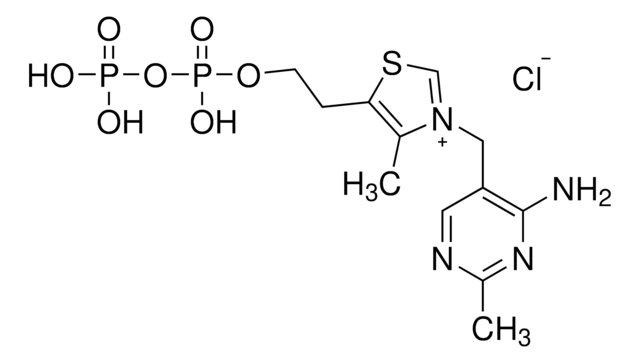Key Documents
D3385
3′-Dephosphocoenzyme A
≥90% (HPLC)
Synonim(y):
3′-Desphosphocoenzyme A, dpCoA
About This Item
Polecane produkty
pochodzenie biologiczne
synthetic (organic)
Poziom jakości
Próba
≥90% (HPLC)
Postać
powder
zanieczyszczenia
≤1% CoA
rozpuszczalność
H2O: soluble-50 mg/mL, clear to slightly hazy, colorless to faintly yellow
temp. przechowywania
−20°C
ciąg SMILES
CC(C)(COP(O)(=O)OP(O)(=O)OCC1OC(C(O)C1O)n2cnc3c(N)ncnc23)C(O)C(=O)NCCC(=O)NCCS
InChI
1S/C21H35N7O13P2S/c1-21(2,16(32)19(33)24-4-3-12(29)23-5-6-44)8-39-43(36,37)41-42(34,35)38-7-11-14(30)15(31)20(40-11)28-10-27-13-17(22)25-9-26-18(13)28/h9-11,14-16,20,30-32,44H,3-8H2,1-2H3,(H,23,29)(H,24,33)(H,34,35)(H,36,37)(H2,22,25,26)
Klucz InChI
KDTSHFARGAKYJN-UHFFFAOYSA-N
Zastosowanie
Działania biochem./fizjol.
Kod klasy składowania
11 - Combustible Solids
Klasa zagrożenia wodnego (WGK)
WGK 3
Temperatura zapłonu (°F)
Not applicable
Temperatura zapłonu (°C)
Not applicable
Środki ochrony indywidualnej
Eyeshields, Gloves, type N95 (US)
Certyfikaty analizy (CoA)
Poszukaj Certyfikaty analizy (CoA), wpisując numer partii/serii produktów. Numery serii i partii można znaleźć na etykiecie produktu po słowach „seria” lub „partia”.
Masz już ten produkt?
Dokumenty związane z niedawno zakupionymi produktami zostały zamieszczone w Bibliotece dokumentów.
Klienci oglądali również te produkty
Nasz zespół naukowców ma doświadczenie we wszystkich obszarach badań, w tym w naukach przyrodniczych, materiałoznawstwie, syntezie chemicznej, chromatografii, analityce i wielu innych dziedzinach.
Skontaktuj się z zespołem ds. pomocy technicznej













